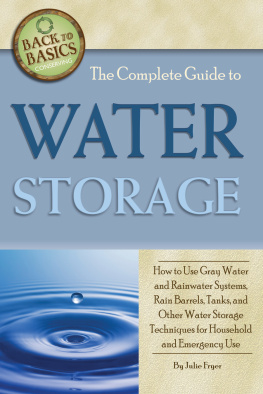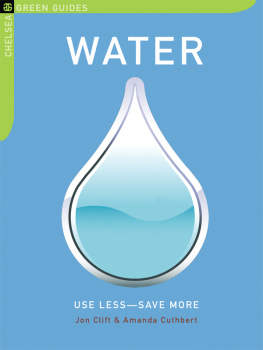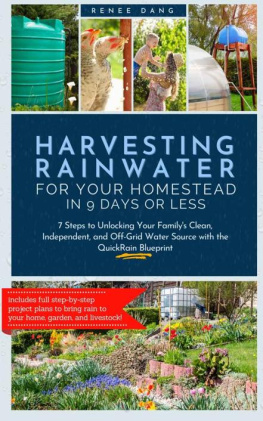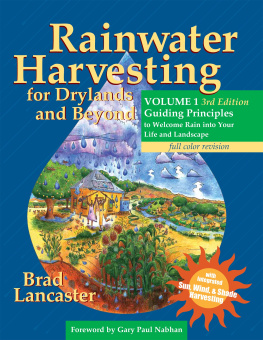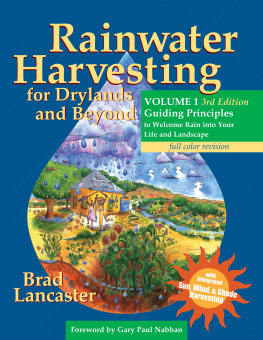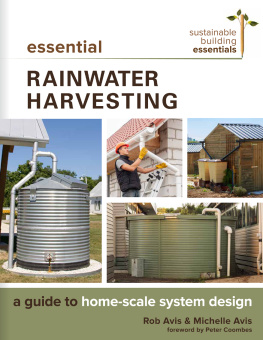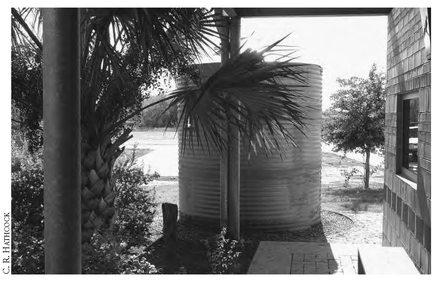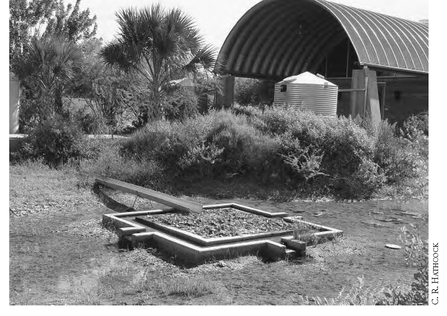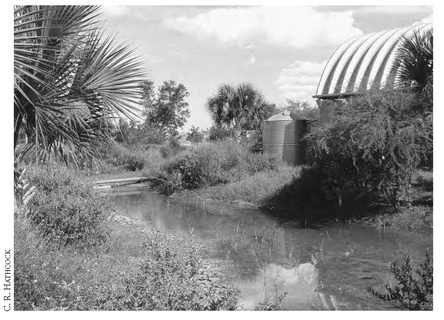Table of Contents
Foreword
RAINWATER COLLECTION links human and environmental systems in mutually reinforcing health. On-site, it supports human life by, in effect, generating a new source of water. Upstream, it reduces the demand to develop off-site water supplies. Downstream, it protects water quantity and quality by reducing excess urban runoff and the associated pollution, erosion, and flooding. The technology and its applications are expanding and being refined.
Its applicability to both arid and humid climates is becoming increasingly clear.
Heather Kinkade-Levario has made herself the leading expert in rainwater collection and its applications through a singular combination of systematic observation, focused academic study, and professional design experience. Her native area is the arid Southwest, where the need for water collection is most glaringly obvious and where the art of water catchment has developed most rapidly. She has been a leader in the American Rainwater Catchment Systems Association, the International Rainwater Catchment Systems Association, and the US Green Building Council.
Heathers first book on the subjectan award-winner in its own rightwas published not long ago. But even since then, industry and design knowledge and applications have evolved and expanded. Advancements are being developed at home in North America, and introduced from Europe. Professional demands have risen for advanced technical information and new types of applications.
This new book raises available rainwater catchment, stormwater collection, and alternate water reuse information to the detailed technical level and broad scope of application required by professional architects, landscape architects, and engineers. It gives us clear writing, abundant case studies, great illustrations, and technical authority. It is organized, comprehensive, and accessible. Through it we see where and how rainwater catchment is being implemented and alternate water reused. We see at work both simple passive systems and the technically more demanding, but hydrologically much more complete and efficient, active systems. This new book elevates professionals awareness and capability by providing the information they need. Immediately upon publication, it has the effect and stature of this growing technologys leading technical guideline and professional information resource.
BRUCE K. FERGUSON, FASLA
Franklin Professor of Landscape Architecture and former
Director, University of Georgia School of Environmental Design
Author, Stormwater Infiltration, Introduction to Stormwater,
and Porous Pavements
Preface
COLLECTING AND STORING rainwater is not a new idea. For almost 4000 years, cultures throughout the world have used captured rainwater. King Mesha of Moab won his war in his quest for land east of Jordan due to making reservoirs for catching water, the water that allowed him to survive through dry times. Wars have been fought and won over ownership of water or the ability to catch rainwater. It has even been said that water may be the oil of the 21st century. Continuing this thought today, collecting and using water more than one time can help reduce dependence on existing fresh water supplies. Much of the municipal water that has been purified to drinking water standards is used for tasks such as house cleaning, flushing toilets, gardening, and washing clothes or cars when drinking-water quality for these tasks is not required.
World Birding Center: One of 18 water tanks that store a total of 45,000 gallons
World Birding Center: Wildlife guzzler fed by an adjacent rainwater tank
Collecting rainwater, stormwater or an alternate water that has been used one time and can be used a second time with little or no treatment could provide a new water supply, saving the purified municipal water for high-quality water needs. Rainwater alone can help to improve poor-quality water, augment inefficient or undependable water supplies, cleanse soil by leaching built-up salt deposits, avoid the need for municipal chlorination and fluoridation treatments, and reduce or eliminate the cost of obtaining an alternate water supply. Drilling a well, laying a pipe for long distances, trenching in rocky conditions, or pumping water to higher elevations may prove to be too costly. In these and other instances, rainwater and stormwater collection as well as alternate water reuse can offer a more cost-effective water supply.
This potential supply of water is especially important in all arid and semi-arid regions where rainfall is neither frequent nor reliable. Collecting the water that falls onto a designated site then retaining that water and/or using water that is generated on site for on-site needs can be important for the sustainability of any design or development of a localized area. Applied consistently over the course of several projects, this water supply can have regional importance for the conservation of limited ground and surface water supplies.
Two water sources that potentially need very little filtration or purification are rainwater and fog condensate. However, both require specific techniques for collection. Fog collection, while it can only apply to specific elevations and geographic fog-producing features, requires large fog collection arrays, troughs, pipes, and water storage tanks. Similarly, the efficient collection of rainwater depends on several factors. First of all, the catchment areathe defined surface area upon which rainwater falls and is collectedshould be carefully chosen. Pollutants introduced from a poorly chosen catchment area can affect the usability of the captured water. Second, the quantity of water to be collected, known as the rainwater harvesting potential, should be carefully evaluated. Third, the conveyance system that carries the water to storage must be designed, and an initial process of removing pollutants, known as a first-flush diversion or roof washing, must be considered. The water must also be stored and then distributed by gravity or by pumping.
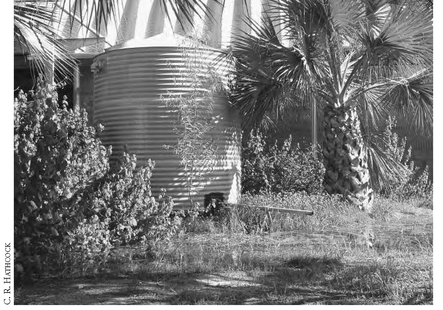
World Birding Center: A 2,400-gallon tank
World Birding Center: A tank next to the arched roof catchment that feeds the adjacent wildlife pond
Stormwater catchment can be for reuse of the water or, more typically, it can be caught for infiltration purposes. Alternate water supplies such as cooling tower bleed-off water, air conditioning condensate, and greywater can and typically are reused for non-potable uses that include landscape irrigation and toilet flushing. While rainwater collection is the main emphasis of this book, the collection and use or reuse of all of these supplies are recommended for applicability to a new or existing project.


